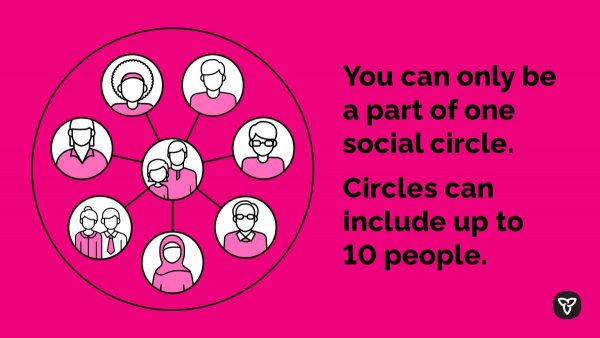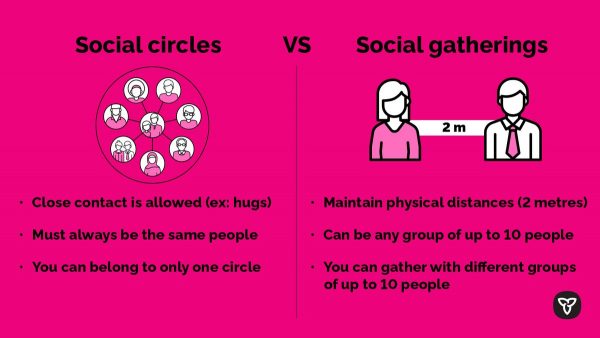People throughout Ontario are being encouraged to establish a social “circle” of no more than 10 people who can interact and come into close contact with one another without physical distancing. Dr. David Williams, Ontario’s Chief Medical Officer of Health, updated public health advice to come into effect immediately province-wide to allow social circles of up to 10 members, including those outside the immediate household. Social circles will support the mental health and well-being of Ontarians and help reduce social isolation.
Details on how to establish a social circle were provided today by Premier Doug Ford, Christine Elliott, Deputy Premier and Minister of Health, and Dr. Williams.
“At the outset of the pandemic, we had to make the necessary, but difficult decision to ban large public gatherings and strongly advise physical distancing with everyone except immediate household members” said Premier Ford. “As the public health trends improve and our collective efforts start to pay off, we’re now able to take another step forward today by allowing families and their loved ones to reunite and spend time with one another safely through social circles.”
Ontarians who wish to form a safe social circle should follow these five simple steps:
- Start with your current circle: the people you live with or who regularly come into your household;
- If your current circle is under 10 people, you can add members to your circle, including those from another household, family members or friends;
- Get agreement from everyone that they will join the circle;
- Keep your social circle safe. Maintain physical distancing with anyone outside of your circle; and
- Be true to your circle. No one should be part of more than one circle.
The province has developed a practical step-by-step guide to help Ontarians as they safely develop and join a social circle.
“Ontarians should think of their circles as the people they can touch, hug and come into close contact as we continue our shared fight against COVID-19,” said Minister Elliott. “While this is an exciting step forward, every Ontarian should follow the advice provided by our public health experts to ensure they do so safely and in a way that limits the spread of this virus, including and especially by only being part of one circle. We all owe it to each other to act responsibly.”
The rules for social circles are different from the proposed expansion of social gatherings from five to 10 people. Social gatherings can be any 10 people from outside your household, but where physical distancing of at least two metres should be maintained. For example, the expansion of social gatherings enables individuals and families to enjoy the company of others at backyard barbeques and picnics in neighbourhood parks, while respecting physical distancing advice.
On the other hand, social circles will enable Ontarians to enjoy close contact with members of their circle. This could include hugging, carpooling, enjoying a patio and sharing a meal without staying two metres apart. Ontarians should avoid close-contact activities with anyone outside of their circle if they are unable to maintain physical distancing. Social circles will also bring back supports from people outside of their household who can now help with children, seniors or those in need.
“Not only will social circles help to improve people’s mental health and reduce social isolation, they will support rapid case and contact tracing by limiting the number of close contacts, in the event of a case of COVID-19 in that circle,” said Dr. Williams.
While physical distancing does not need to be practised between members of the same social circle, other public health advice, including frequent hand washing, should be maintained. Anyone who is ill or feeling sick should immediately limit their contact with anyone in their circle, inform the other members of the circle, self-isolate, and seek testing if they have COVID-19 symptoms, by visiting one of the 145 assessment centres across Ontario. They should also seek testing if they are concerned that they might have been exposed to COVID-19 or be at risk.
Quick Facts
- Anyone who is ill or feeling sick should immediately stop contact with anyone in their social circle, seek assistance from a health care professional or consider being tested for COVID-19.
- The number of COVID-19 assessment centres is changing regularly. People are encouraged to check the ministry website (https://covid-19.ontario.ca/assessment-centre-locations) or their local public health unit.
- Individuals at higher risk, including those over 70 and individuals with compromised immune systems and/or underlying medical conditions, may choose not to participate in a social circle depending on their unique circumstances.
- While physical distancing does not need to be practised inside the social circle, other public health advice, including frequent hand washing, respiratory etiquette, and not touching your eyes, nose or mouth should be maintained.
Create a safe social circle
Follow these steps to create a safe circle.
Step 1: Start with your current circle: anyone you live with or who regularly comes into your household
Be sure to include anyone that would come into regular close contact with you and the people you live with.
This may be:
- family members, including children
- your roommates
- another parent to your child(ren) that lives outside the home
- a babysitter or caregiver
Considerations
If you add people outside of your household to your social circle, be sure to include anyone in their households as well. You may not see them often, but they would still be considered part of your current circle.
Remember that everyone in a household must be part of the same social circle.
Step 2: If under 10 people, you can add members to your social circle, including another household, family members or friends
As you add additional members, ask yourself:
- Do they live with or come into regular close contact with anyone else? You may never see them, but they would still be considered part of your social circle.
- What makes most sense for you or your household? That could include another household with similarly-aged children or family members that you want to spend more time with.
Considerations
If you live alone, you may want to start with family members or other close friends. People may, or may not, choose to participate in a social circle depending on their unique circumstance, and risk of developing complications from COVID-19, for example people:
- over 70
- with compromised immune systems
- with underlying medical conditions
Remember that your social circle can include fewer than 10 people. It’s always best to start slow and safely add more members later.
Step 3: Get agreement from everyone that they will join the social circle
That means they agree to join only one circle, and physically distance with anyone outside the circle.
Essential workers can be part of a social circle, so long as the other members are aware of the risks and agree to them.
Step 4: Keep your social circle safe
To keep the people in your social circle safe:
- continue to follow public health advice, including frequent hand washing and sneezing and coughing into a sleeve
- continue to physically distance with anyone outside your circle by keeping two metres or six feet apart from them
If someone in your circle feels sick
They should immediately inform other members of the circle, self-isolate at home and not come into close contact with anyone, including other members of the circle.
They should also get tested.
Find an assessment centre to get tested for COVID-19.
Everyone else in the circle should closely monitor themselves for symptoms of COVID-19. If you believe you have been exposed to COVID-19 you should also be tested.
Step 5: Be true to your social circle
No one should be part of more than one circle.
Learn about examples of social circles and learn how to create your own in this step-by step guideline.
- Tuesday Morning News – December 23rd - December 23, 2025
- Winter Road Conditions & Weather – Tuesday, December 23rd - December 23, 2025
- Monday Morning News – December 22 - December 22, 2025
 Wawa-news.com You can't hear the 'big picture'!
Wawa-news.com You can't hear the 'big picture'!



